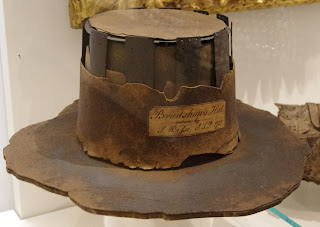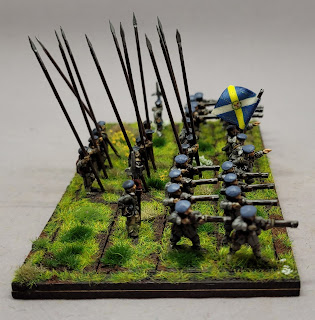Oxford, The King's Capital
In the interests of varsity equal opportunities, after visiting Cambridge, it was only a matter of time before the ECW travelogue made a flask up and ventured south to...
 |
| Bradshaw's Hat, on display at the Ashmolean. Lord President, Bradshaw reputedly wore the reinforced hat during the trial of Charles I in case of an assassination attempt* |
Charles set up court at Christ Church in October 1642, and would ultimately set up a rival Parliament in the city in 1644. Besieged many times by Parliament, the city was significantly fortified, and the garrison far outnumbered the resident population.
What's There Today?
Probably the best place to start is the Ashmolean Museum: one of the world's great treasure houses there are a number of artefacts on display relating to the Civil War. The Ashmolean also has a self guided Civil War Trail available.
 |
| Portrait of Prince Rupert (left), possibly Colonel William Legge governor of Oxford (centre), and Colonel John Russell (right). William Dobson circa 1645 |
 |
| Self-portrait of Robert Walker, court painter to Charles I. 1640s. |
 |
| Miniature enamel painting of Cromwell by Henry Bone 1855. |
 |
| Leather patchwork shoe supposedly belonging to John Bigg. Bigg was reputed to have been one of Charles I's executioners. |
 |
| Victorian copy of Cromwell's death mask - note the warts |
The Ashmolean has an extensive collection of siege coins on display - not just Oxford coins, but also Newark and Pontefract coins.
 |
| Gold, three pound Oxford coin. |
 |
| Oxford crown, this is the 'tails' side of the coin, rather than the more famous image of Charles I on horseback. |
New College was the site of the Royalist powder stores.
St John's College was the residence of Charles's nephews, Prince Rupert and Prince Maurice.
 |
Bodleian Library, used as the set for Hogwart's Library in the Harry Potter film, was the site of Charles's Oxford Parliament. A statue of the 3rd Earl of Pembroke stands outside.
University Church of St Mary the Virgin - the statue of Mary on the porch was shot at by Parliamentarian soldiers who believed it was too ostentatious/idolatrous and therefore too Catholic. Mary and Jesus's heads were shot off but were replaced during the 1660s, Mary's body still bears the marks of musket balls.
Merton College was Queen Henrietta's residence.
As you walk back down Merton Street keep an eye out for 3 Merton Street (opposite Merton College Chapel, currently painted pink). On the side of number 3 is a plaque marking the birthplace of regicide Colonel Henry Marten.
As you walk down Grove Walk if you look closely you'll notice a bricked up gateway in the wall next to Corpus Christi College - this is known as the King's Gate and allowed Charles access to Merton College, and his wife's accommodation. (If you are struggling, it is near the iron gate close to Deadmans Walk)
Christ Church meadow saw a cannon ball land here as a warning shot prior to the surrender of Oxford.
Christ Church College was commandeered as Charles's residence and court.
The Cathedral has the tombs of many prominent Royalists.
 |
| Looking towards the Cathedral, the building in the foreground is The Hall |
 |
| Sir Henry Gage |
 |
| Sir William Pennyman |
Oxford Museum has a number of items of interest, located in Oxford's Town Hall. Recently reopened after a major renovation, the museum has tripled in size. Highlights include the Chadlington sword which was found hidden in the thatch roof of a house in Chadlington in the 1920s, and a gorget found in the Thames at Godstow.
St Michael's Street, and the building that was the Old St Mary's College (now Frewin Hall, an annexe of Brasenose College) was a military hospital and ordinance factory.
The Castle was used as a prison for captured Parliamentarian soldiers. So bad were the conditions that the prisoners were held in, that many joined the Royalist cause just to escape the castle.
Outside the city:
Marston is a village a few miles outside the city centre: it was here at Cromwell's House on Mill Lane that the surrender of Oxford was negotiated.
The local church, St Nicholas's, was used as an observation post - the tower giving good views of the south of the city.
Also in Marston is the Victoria Arms which claims that Oliver Cromwell sat there whilst waiting for Oxford to surrender. Whether this is fact or another fanciful Cromwell story we don't know. They do have a small display hanging on one of their fireplaces. If you come out to Marston, you may as well rest your feet and have a spot of lunch whilst you are there.
Newbridge in Moreton is the site of an ancient bridge which was in the site of the action during the first siege of Oxford: Waller's forces were repulsed by Royalist dragoons. The bridge was structurally assessed after the floods of 2007, apparently one of the arches is rather weak, so maybe best to drive very quickly over it!
Select Bibliography
Cavalier Capital, Oxford in the English Civil War 1642-1646 John Barratt, Helion
Postcodes for SatNavs
Ashmolean Museum, Beaumont Street OX1 2PH
New College, Holywell Street OX1 3BN
St John's College, St Giles' OX1 3JP
Threeways House, Gloucester Street OX1 2BJ
Bodleian Library, Broad Street OX1 3BG
University Church of St Mary the Virgin, the High Street OX1 4BJ
All Souls College, Catte Street OX1 4AL
Oriel College, Oriel Street OX1 4EW
Merton College, Merton Street OX14JD
King's Gate, Grove Walk (shown as Merton Grove on GoogleMaps)
Christ Church meadow, St Aldate's OX1 1DP
Christ Church College, St Aldate's OX1 1DP
Christ Church Cathedral, St Aldate's OX1 1DP
* Pretty unlikely, surely any disgruntled Royalists would more likely take the risk to rescue the king rather than assassinate Bradshaw. That's even before one looks at how much protection such a hat would afford the wearer. Or the absence of evidence that this hat was even worn by Bradshaw, let alone at the trial.
Select Bibliography
Cavalier Capital, Oxford in the English Civil War 1642-1646 John Barratt, Helion
Postcodes for SatNavs
Ashmolean Museum, Beaumont Street OX1 2PH
New College, Holywell Street OX1 3BN
St John's College, St Giles' OX1 3JP
Threeways House, Gloucester Street OX1 2BJ
Bodleian Library, Broad Street OX1 3BG
University Church of St Mary the Virgin, the High Street OX1 4BJ
All Souls College, Catte Street OX1 4AL
Oriel College, Oriel Street OX1 4EW
Merton College, Merton Street OX14JD
King's Gate, Grove Walk (shown as Merton Grove on GoogleMaps)
Christ Church meadow, St Aldate's OX1 1DP
Christ Church College, St Aldate's OX1 1DP
Christ Church Cathedral, St Aldate's OX1 1DP
Museum of Oxford, Oxford Town Hall OX1 1BX
Frewin Hall, New Inn Hall Street OX1 2DW (best viewed from St Michael's Street)
Oxford Castle OX1 1AY
Frewin Hall, New Inn Hall Street OX1 2DW (best viewed from St Michael's Street)
Oxford Castle OX1 1AY
Rhodes House OX1 3RG
Cromwell's House, Mill Lane OX3 0PY
St Nicholas's Church, Marston OX3 0PR
Cromwell's House, Mill Lane OX3 0PY
St Nicholas's Church, Marston OX3 0PR
Victoria Arms, Marston OX3 0PZ
Newbridge, Moreton OX29 7QD
Newbridge, Moreton OX29 7QD
If you enjoyed reading this, or any of the other posts, please consider supporting the blog.
Thanks.































Comments
Post a Comment